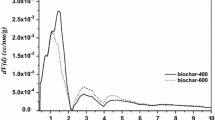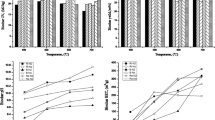Abstract
To evaluate the agronomic potential of biochar, we prepared a series of biochars using rice straw waste under the limited oxygen cracking condition (CO2 or N2) and the different pyrolysis temperatures including 300, 400, 600, and 800 °C. The results showed that morphology structure, specific surface area, pore size distribution, and element contents of the biochars were superior to the biochars prepared under traditional inert atmosphere (N2) and the same four pyrolysis temperatures. In comparison with the rice straw, pore structure of biochars was mainly mesoporous and more developed, average pore size decreased, and BET-specific surface area increased with the increase of temperature from 300 to 800 °C. Biochars distributed abundant mesopores and macropores under 400 and 600 °C; the maximum macropores of the biochar were shaped under 600 °C. Concentration of phosphorus (P) and potassium (K) increased significantly with increasing temperature, while that of nitrogen (N) first increased and then decreased and reached a maximum at 400 °C. In addition, taking these physiochemical properties into consideration, we drew a conclusion that the optimum quality biochar could acquire under the work conditions of 400 °C and CO2 atmosphere, which was supposed to provide theoretical guidance for biochar returning to soil.









Similar content being viewed by others
References
Wardle DA, Nilsson MC, Zackrisson O (2008) Fire-derived charcoal causes loss of forest humus. Science 320(5876):629
Xu G, Lü YC, Sun JN, Shao HB, Wei LL (2012) Recent advances in biochar applications in agricultural soils: Benefits and environmental implications. Clean Soil Air Water 40(10):1093–1098
Sohi S (2013) Biomass, bioenergy and the sustainability of soils and climate: what role for biochar? In: EGU general assembly conference. EGU general assembly conference abstracts
Deng X (2012) Effects of Giant reed biochar on nitrogen bioavailability in the agricultural soil. Ocean University of China, Qingdao (in Chinese)
Yue Y, Cui L, Lin Q, Li G, Zhao X (2017) Efficiency of sewage sludge biochar in improving urban soil properties and promoting grass growth. Chemosphere 173:551–556
Brassard P, Godbout S, Raghavan V (2016) Soil biochar amendment as a climate change mitigation tool: key parameters and mechanisms involved. J Environ Manag 181:484–497
Biederman LA, Harpole WS (2013) Biochar and its effects on plant productivity and nutrient cycling: a meta-analysis. Glob Change Biology Bioenergy 5:202–214
Keiluweit M, Nico PS, Johnson MG, Kleber M (2010) Dynamic molecular structure of plant biomass-derived black carbon (biochar). Environ Sci Technol 44(4):1247–1253
Cha JS, Park SH, Jung S, Ryu C, Jeon J, Shin M et al (2016) Production and utilization of biochar: a review. J Ind Eng Chem 40:1–15
Gaskin JW, Steiner C, Harris K, Das KC, Bibens B (2008) Effect of low-temperature pyrolysis conditions on biochar for agricultural use. Trans ASABE 51:2061–2069
Ro KS, Cantrell KB, Hunt PG (2010) High-temperature pyrolysis of blended animal manures for producing renewable energy and value-added biochar. Ind Eng Chem Res 49:10125–10131
Zabaniotou A, Stavropoulos G, Skoulou V (2008) Activated carbon from olive kernels in a two-stage process: industrial improvement. Biores Technol 99:320–326
Jeffery S, Bezemer TM, Cornelissen G, Kuyper TW, Lehmann J, Mommer L et al (2013) The way forward in biochar research: targeting trade-offs between the potential wins. Glob Change Biol Bioenergy 7:11–13
Cao XD, Harris W (2010) Properties of dairy-manure-derived biochar pertinent to its potential use in remediation. Biores Technol 101:5222–5228
Cantrell KB, Hunt PG, Uchimiya M, Novak JM, Ro KS (2012) Impact of pyrolysis temperature and manure source on physicochemical characteristics of biochar. Biores Technol 107:419–428
Park SH, Cho HJ, Ryu C, Park Y (2016) Removal of copper(II) in aqueous solution using pyrolytic biochars derived from red macroalga Porphyra tenera. J Ind Eng Chem 36:314–319
Sun Y, Zhang JP, Guo F, Zhang L (2016) Hydrochar preparation from black liquor by CO2 assisted hydrothermal treatment: optimization of its performance for Pb2+ removal. Korean J Chem Eng 33:2703–2710
Ahmadi M, Kouhgardi E, Ramavandi B (2016) Physico-chemical study of dew melon peel biochar for chromium attenuation from simulated and actual wastewaters. Korean J Chem Eng 33:2589–2601
Li G, Zhu W, Zhu L, Chai X (2016) Effect of pyrolytic temperature on the adsorptive removal of p-benzoquinone, tetracycline, and polyvinyl alcohol by the biochars from sugarcane bagasse. Korean J Chem Eng 33:2215–2221
Ruthiraan M, Mubarak NM, Thines RK, Abdullah EC, Sahu JN, Jayakumar NS et al (2015) Comparative kinetic study of functionalized carbon nanotubes and magnetic biochar for removal of Cd2+ ions from wastewater. Korean J Chem Eng 32:446–457
Verheijen F, Jeffery S, Bastos AC, van der Velde M, Diafas I (2010) Biochar application to soils. A critical scientific review of effects on soil properties, processes and functions. European Commission Joint Research Centre, Institute for Environment and Sustainability, Luxemburg, p 149
Jin J, Li Y, Zhang J, Wu S, Cao Y, Peng L et al (2016) Influence of pyrolysis temperature on properties and environmental safety of heavy metals in biochars derived from municipal sewage sludge. J Hazard Mater 320:417
Pituello C, Francioso O, Simonetti G, Pisi A, Torreggiani A, Berti A et al (2015) Characterization of chemical–physical, structural and morphological properties of biochars from biowastes produced at different temperatures. J Soils Sediments 15:792–804
Lee J, Yang X, Cho S, Kim J, Lee SS, Tsang DCW et al (2017) Pyrolysis process of agricultural waste using CO2 for waste management, energy recovery, and biochar fabrication. Appl Energy 185:214–222
Yuan H, Lu T, Huang HY, Zhao DD, Kobayashi N, Chen Y (2015) Influence of pyrolysis temperature on physical and chemical properties of biochar made from sewage sludge. J Anal Appl Pyrol 112:284–289
Chen Y, Yang H, Wang X, Zhang S, Chen H (2012) Biomass-based pyrolytic polygeneration system on cotton stalk pyrolysis: influence of temperature. Bioresour Technol 107:411
Peng P, Lang Y, Wang X (2016) Adsorption behavior and mechanism of pentachlorophenol on reed biochars: pH effect, pyrolysis temperature, hydrochloric acid treatment and isotherms. Ecol Eng 90:225–233
Lu K, Yang X, Shen J, Robinson B, Huang H, Liu D et al (2014) Effect of bamboo and rice straw biochars on the bioavailability of Cd, Cu, Pb and Zn to Sedum plumbizincicola. Agric Ecosyst Environ 191:124–132
Zhang R, Li Z, Liu X, Wang B, Zhou G, Huang X et al (2017) Immobilization and bioavailability of heavy metals in greenhouse soils amended with rice straw-derived biochar. Ecol Eng 98:183–188
Jian MF, Gao KF, Yu HP (2016) Effect of different pyrolysis temperatures on the preparation and characteristics of bio-char from rice straw. Acta Sci Circumst 36:1757–1765 (in Chinese)
Shen DK, Gu S (2009) The mechanism for thermal decomposition of cellulose and its main products. Biores Technol 100(24):6496–6504
Vamvuka D, Sfakiotakis S (2011) Effects of heating rate and water leaching of perennial energy crops on pyrolysis characteristics and kinetics. Renew Energy 36(9):2433–2439
Yang HP, Yan R, Chen HP, Zheng CG, Lee DH, Liang DT (2006) In-depth investigation of biomass pyrolysis based on three major components: hemicellulose, cellulose and lignin. Energy Fuels 20(1):388–393
Li L, Lu YC, Liu YY, Sun HW, Liang ZY (2012) Adsorption mechanisms of cadmium(II) on biochars derived from corn straw. J Agro-Environ Sci 31(11):2277–2283 (in Chinese)
Bagreev A, Bandosz TJ, Locke DC (2001) Pore structure and surface chemistry of adsorbents obtained by pyrolysis of sewage sludge-derived fertilizer. Carbon 39(13):1971–1979
Mustafa KH, Vladimir S, Chan KY, Ziolkowski A, Nelson PF (2011) Influence of pyrolysis temperature on production and nutrient properties of wastewater sludge biochar. J Environ Manag 92(1):223–228
Zheng H, Wang ZY, Deng X, Zhao J, Luo Y, Novak J et al (2013) Characteristics and nutrient values of biochars produced from giant reed at different temperatures. Biores Technol 130:463–471
Ren QQ, Zhao CS, Wu X, Liang C, Chen XP, Shen JZ et al (2010) Formation of NOx precursors during wheat straw pyrolysis and gasification with O2 and CO2. Fuel 89(5):1064–1069
Lehmann J, Joseph S (2009) Biochar for environmental management: science and technology. Earthscan 25(1):15801–15811
Harvey OR, Herbert BE, Kuo LJ, Louchouarn P (2012) Generalized two-dimensional perturbation correlation infrared spectroscopy reveals mechanisms for the development of surface charge and recalcitrance in plant-derived biochars. Environ Sci Technol 46:10641–10650
Kinney TJ, Masiello CA, Dugan B, Hockaday WC, Dean MR, Zygourakis K et al (2012) Hydrologic properties of biochars produced at different temperatures. Biomass Bioenergy 41(5):34–43
Suliman W, Harsh JB, Abu-Lail NI, Fortuna AM, Dallmeyer I, Garcia- Perez M (2016) Influence of feedstock source and pyrolysis temperature on biochar bulk and surface properties. Biomass Bioenergy 84:37–48
Ronsse F, Hecke SV, Dickinson D, Prins W (2013) Production and characterization of slow pyrolysis biochar: influence of feedstock type and pyrolysis conditions. Glob Change Biol Bioenergy 5(2):104–115
Zhou ZL, Shi DJ, Qiu YP, Sheng D (2010) Sorptive domains of pine chars as probed by benzene and nitrobenzene. Environ Pollut 158(1):201–206
Wang DJ, Zhang W, Hao XZ, Zhou DM (2013) Transport of biochar particles in saturated granular media: effects of pyrolysis temperature and particle size. Environ Sci Technol 47(2):821–828
Liu DW, Yu Y, Wu HW (2013) Differences in water-soluble intermediates from slow pyrolysis of amorphous and crystalline cellulose. Energy Fuels 27(3):1371–1380
Xiao X, Chen B, Zhu L (2014) Transformation, morphology, and dissolution of silicon and carbon in rice straw-derived biochars under different pyrolytic temperatures. Environ Sci Technol 48(6):3411–3419
Uchimiya M, Hiradate S (2014) Pyrolysis temperature-dependent changes in dissolved phosphorus speciation of plant and manure biochars. J Agric Food Chem 62(8):1802–1809
Singh B, Singh BP, Cowie AL (2010) Characterisation and evaluation of biochars for their application as soil amendment. Aust J Soil Res 48(7):516–525
Kloss S, Zehetner F, Dellantonio A (2012) Characterization of slow pyrolysis biochars: effects of feedstocks and pyrolysis temperature on biochar properties. J Environ Qual 41(4):990–1000
Cheah S, Malone SC, Feik CJ (2014) Speciation of sulfur in biochar produced from pyrolysis and gasification of oak and corn stover. Environ Sci Technol 48(15):8474–8480
Lin XF, Zhang J, Yin YS (2009) Study on fractal characteristics of biomass chars. Biomass Chem Eng 43:10–12
Acknowledgements
This study was supported by the National Natural Science Foundation of China (No. 41571283) and National Key Research and Development Program of China (2016YFD0800702).
Author information
Authors and Affiliations
Corresponding author
Rights and permissions
About this article
Cite this article
Tan, Z., Zou, J., Zhang, L. et al. Morphology, pore size distribution, and nutrient characteristics in biochars under different pyrolysis temperatures and atmospheres. J Mater Cycles Waste Manag 20, 1036–1049 (2018). https://doi.org/10.1007/s10163-017-0666-5
Received:
Accepted:
Published:
Issue Date:
DOI: https://doi.org/10.1007/s10163-017-0666-5




